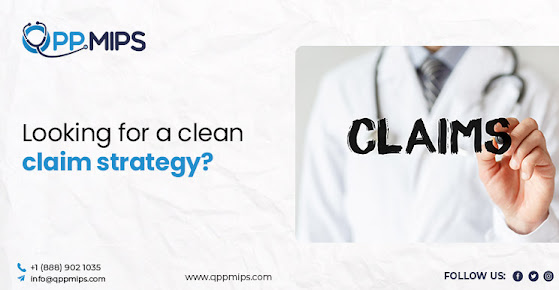How Clean Claims Impact Medical Practice in Outsourced Medical Billing Services
Without implementing a clean claim submission approach, your practice can face revenue losses, increased claim denials, and delays in receiving insurance reimbursements.
It can adversely affect the entire revenue cycle.
Let MIPS Reporting experts perform a detailed medical billing audit to identify problems in your entire revenue cycle process.
Learn about the opportunities to increase revenue for your practice.
Medical billing can be complex and tedious, but one thing is clear: clean claims are the backbone of a successful billing process. If you want to keep your medical practice running smoothly, understanding and mastering the art of submitting clean claims is essential Neurology Billing Services.
What Exactly Is a Clean Claim?
Simply put, a clean claim is one that is correctly completed and contains all the necessary information, allowing it to be processed without any hiccups. When a claim is clean, the insurance company can handle it efficiently without requiring additional information or corrections.
The Importance of Clean Claims in Medical Billing
In medical billing, time is money. Clean claims ensure that payments are processed quickly, keeping your practice’s revenue cycle flowing. On the other hand, dirty claims—those filled with errors or missing crucial information—cause delays, denials, and resubmissions, bogging down your cash flow and frustrating both your staff and your patients.
The Anatomy of a Clean Claim
So, what makes a claim “clean”? Here’s a breakdown:
- Accurate patient information: Correct names, dates of birth, and insurance details are crucial.
- Correct coding: Using the right medical codes (ICD-10, CPT, HCPCS) ensures the claim reflects the services provided.
- Complete documentation: Missing documents or information can stall a claim's approval process.
Common Errors Leading to Claim Rejections
A minor typo, an incorrect code, or a missing signature can turn a clean claim into a dirty one. Some of the most common reasons for claim rejections include:
- Inaccurate patient demographics
- Incorrect insurance details
- Missing authorizations or referrals
- Coding errors or mismatched codes
- Lack of proper documentation
Why Clean Claims Are Crucial for Your Medical Practice
Clean claims play a pivotal role in ensuring:
- Improved cash flow: Clean claims lead to quicker reimbursements, helping maintain a steady revenue stream.
- Operational efficiency: Fewer rejections mean less time wasted on resubmissions, freeing your staff to focus on other tasks.
- Higher patient satisfaction: When claims are processed smoothly, patients feel more confident in your practice and experience fewer billing issues.
How Clean Claims Reduce Denials
Denials can be a significant source of frustration and financial strain for medical practices. Common reasons for denials include incorrect coding, missing documentation, and ineligible services. Clean claims mitigate these risks by ensuring every "i" is dotted and every "t" is crossed.
Impact of Dirty Claims on Revenue Cycle Management
Dirty claims slow down the entire revenue cycle. Payments get delayed, resubmissions pile up, and your staff spends hours fixing mistakes. This not only affects your practice's financial health but also puts additional stress on your team.
Improving Your Practice’s Clean Claim Rate
Boosting your clean claim rate starts with the basics:
- Staff training: Well-trained staff are less likely to make common errors.
- Regular audits: Routine checks help catch errors before they become costly problems.
- Billing software: Modern billing systems can help automate many of the checks needed for clean claim submissions.
The Role of Accurate Documentation in Clean Claims
Accurate and complete documentation is the foundation of a clean claim. It ensures that the services provided are accurately reflected in the claim. If your documentation is lacking, even the best billing team will struggle to submit clean claims.
How Technology Facilitates Clean Claims
Today’s medical billing software offers tools like claim scrubbing and automated error detection, which help flag potential issues before submission. These systems can dramatically reduce errors, leading to higher clean claim rates and faster payments.
Key Strategies for Submitting Clean Claims
Submitting clean claims doesn’t have to be rocket science if you follow these key strategies:
- Ensure proper coding: Always use the latest coding manuals and double-check your codes.
- Double-check patient information: Verify that all patient details are accurate and up to date.
- Submit claims promptly: Timely submissions reduce the risk of claim rejections due to expired filing windows.
How to Avoid Common Errors in Medical Billing
Mistakes happen, but they don’t have to. Common errors like incorrect patient information, coding mistakes, and missing documentation can easily be avoided with diligent checks and balances.
The Role of Medical Billers in Maintaining Clean Claims
Your billing staff are the gatekeepers of clean claims. Their collaboration with healthcare providers, attention to detail, and knowledge of coding systems are crucial in maintaining a high clean claim rate.
The Connection Between Clean Claims and Patient Experience
Dirty claims don’t just affect your practice’s revenue—they can impact patient trust and satisfaction. A denied claim often results in billing confusion for patients, which can hurt your reputation.
The Financial Impact of Clean Claims on Medical Practices
Clean claims have a direct impact on your bottom line. When claims are approved quickly, you spend less time and resources on rework, and payments come in faster. This reduces overhead costs and helps your practice run more efficiently General Surgery Billing Services.
Future Trends in Clean Claims Management
As technology advances, automation and artificial intelligence (AI) are playing a bigger role in medical billing. These tools can further improve clean claim rates by reducing human error and streamlining the claims process.
Conclusion
Clean claims are the lifeblood of a thriving medical practice. By focusing on accuracy, training, and the use of technology, you can significantly reduce claim rejections, improve cash flow, and enhance patient satisfaction. Clean claims aren’t just about getting paid faster—they’re about running a more efficient and patient-friendly practice.
Read More: Important QPP MIPS Reporting and Registry Reporting in MIPS Solution


%20(2).jpg)

Comments
Post a Comment